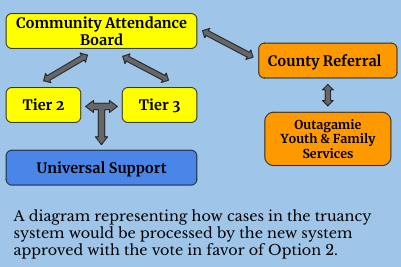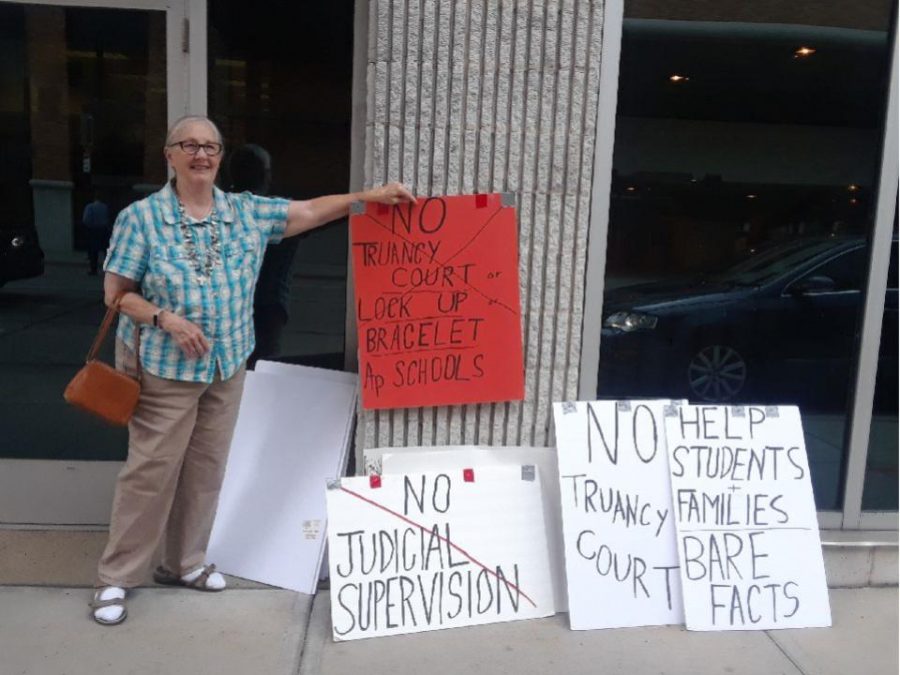AASD Board convenes to vote on truancy court options
Ronna Swift, Truancy Task Force member, waiting downtown at the Thomas G. Scullen Leadership Center before the meeting.
September 9, 2019
The AASD Board of Education convened on August 12 to discuss and vote on three options that were presented as replacements to Truancy Court, which was abruptly shut down at the end of last year. The meeting mostly dealt with habitual truants, adolescents who are absent without an acceptable excuse for part or all of five or more days on which school is held during a school semester according to Wisconsin legislature. These students’ involvement with judges in the county court system sparked a 2018 inquiry into what appeared to be several missteps on the part of authorities. The district eventually suspended the County Court System’s involvement in the truancy system last December after a long period of community concern and protest.
Much of the investigation had to do with what seemed like severe punitive actions taken by Outagamie County in which students were stripped from their parents’ care, placed in shelter-care, and even given ankle bracelets in various scenarios, despite the fact that some kids were dealing with disabilities, trauma, and other issues. Over the near decade that the old truancy court system was in place, more than a thousand citations were handed out, leading to several controversial court cases. As a result of the fallout, the AASD created an Advisory Truancy Task Force to conduct research on other school district’s systems and alternative solutions to address attendance problems. Their findings were reviewed by the AASD this summer and used to draft plans for moving forward.
While the majority of public scrutiny had to with the situation in the county court system, community members felt that the AASD could be held accountable to some degree. The school district is where each of these truancy cases originally developed and processed through, and they were involved in the police issued citations that resulted in students standing in front of judges. According to Wisconsin State Statute 118.16(2).(cg)(4), a school district must first notify a family of their status of habitual truancy and make attendance records available before getting legal authorities involved. During the meeting, some Board members admitted that these steps defined in the statute were ignored prior to writing up citations in the early years of the system. Overall, there was a shared consensus among the Board that the AASD should have had more precautionary measures in place for certain cases preliminary to submitting them to the judicial process.
Before the start of the Board meeting, a public conference was held allowing the School Board to ask questions and go over what each option pertained. All seven members were present along with AASD Superintendent, Dr. Judy Baseman. Representatives of the appointed Truancy Task Force were also in attendance; however, they were not permitted to speak until later with the rest of the community.
Of the three options considered, all included the use of a multi-tiered support system and a Community Attendance Board, headed by an attendance coordinator who would have to be hired at the expense of the district. The tiered system comprises of a base level of universal aid and resources available to everyone. For students who require additional help, they would be placed in either Tier 2 or Tier 3, depending on their needs.
The universal support system is supposed to reach kids by prioritizing that attendance rules are addressed in all classrooms, especially those transitioning between different school levels, while also taking advantage of opportunities like Wellness screenings and absent-student home phone calls to diagnose potential issues. Meanwhile, Tier 2 and Tier 3 target students who have been thereafter identified with problems, directing them to resources such as home visits, home letters, mentoring, the STAR program, IEP meetings, SST involvement, TRAC, and the AASD’s At-Risk Program. While many of these resources already existed in the district, the new tier system is designed with the intent of providing a more thorough check that all options were considered before turning to more severe measures and consequences. The emphasis is on the system’s flexibility, allowing for interchangeable movement between tiers. Whether an individual’s journey follows a linear process or skipping steps, these tiers are designed so no one goes through unnecessary hoops or gets turned away from answers.
The three replacement options were presented to aid in cases where truancy court issues are unable to find resolutions using the tier system. That’s where the different options come in. With Option 1, the Community Attendance Board would get the final say in managing cases as a last resort option. This was a consideration that would have brought drastic changes considering the way things were during the in-statement of the old system, where there traditionally were two routes that involved legal proceedings. One way was through a county referral that involves kids occasionally ending up in juvenile courts. The other scenario comes from citations issued by the Appleton Police Department, leading to the face to face meeting in front of a county judge. The premise of Option 2 was to only give the Community Attendance Board the choice of moving forward with a county referral. On the other hand, Option 3 was created with the intention of allowing both of these options on the table, more similar to the truancy system of recent years.

It was at this point after the three proposals were explained that the Board of Education asked for clarifications and more insight. Accordingly, much of the debate between board members focused on the contrasts between citations and county referrals. The focal point centered upon the fact that the two are separate processes, even though they share some of the same people involved. In simple terms, county referrals get cases sent to the Outagamie’s Youth & Family Services Division where the juvenile court system resides. From there, social workers and other assets are available in a process that is usually more geared towards kids and groups, although the possibility for truants to end up in higher courts still exists. Citations, conversely, follow a process that more directly leads to county judges and the regular criminal system. They end up on records that do not go away for long periods of time and can affect applications for jobs, renting, and other matters, which was one of the concerns to the public.
Another topic of interest was a presentation of alternate truancy systems used in other cities and states. Talk ensued of the AASD modeling their efforts based on a plan developed by Spokane County in Washington. Reviews were mostly positive but still mixed across the Board about the idea. One concerning statistic was brought up that Washington has one of the highest chronic absenteeism rates in the country, which has been reported as high as 17% of the student population in recent years. Moreover, a Board member made a claim stating that a high percentage of Spokane cases ended up in regular court anyway. Yet, there was a lot of praise from other school districts that adopted the county’s measures around the nation. Additionally, the AASD would be in full control choosing which Spokane methods get included in our new system and which are filtered out. As a side note, School Board member Leah Olson also referenced the Menominee Tribal School District for their commendable work with their own truancy system and suggested them as a possible guide as well.
Following a brief intermission from the discussion and the actual Board meeting, numbers of news reporters and families flooded into the room. Community members were then finally able to provide their own public input right before the voting began. The room erupted emotionally as affected families, Truancy Task Force members, and other speakers testified to their experiences and opinions. One mother vividly recounted her experience where her kindergarten daughter was put in handcuffs at her school by police. As someone who had moved from another state, she expressed how shocked she was given the circumstances that played out since she could not fathom a similar situation occurring in the family’s old school district. The stories continued as another mother and a daughter took turns to speak about their family member’s experience after transferring from a larger metropolitan school district. The girl from their family, who had experienced extreme trauma just prior to her truancy court dealings, was forced by authorities into a shelter for three days due to problems with absenteeism. The mother said that neither the school or police notified her of where her daughter was taken, scaring her into filing a missing persons report and believing she had run away. Only after countless hours passed did she find out what really happened. More citizens spoke out with concerns and stories as well, ranging from specific incidents to the hypothetical. Of the speakers who choose to share which option they preferred that the Education Board select, Option 2 was by far the most heavily endorsed.
When the time came for the vote, tensions did not die down as Board members took the reins. Aggressive words and moments of disagreements broke out between the elected officials, that had been nonexistent at the informational meeting just hours before. Referenced during speeches, some of the arguments between members had spilled onto online posts into the days leading up to the vote.
Mr. Dupree was one of the most outspoken members and voiced his opinion in one of the longer addresses made during the vote. He spoke of being upset that the AASD did not provide a viable no-court option, which the Truancy Task Force originally called for, and declared it as “a lack of due diligence” on everyone’s part even though he did end up supporting Option 2. Mr. Dupree also made his concerns clear to the Board about the lack of consistent data used in measuring the truancy system’s success in the past. This was a matter that was discussed earlier with the new proposals and was supposed to be revamped.
As members finally gave closing statements, it became apparent that there was near unanimous support for Option 2. By a vote of 6-1, the second proposal was passed with an amendment made for the Appleton Education Board to meet in a year’s time to discuss progress with the new system. The lone “nay” came from member Barry O’Connor, who cited part of his reasoning as the process for county referrals requiring too much time to see action. The Board was told earlier when it was asked, that it could take 6-8 weeks for proceedings to move forward with Youth & Family Services. As a former administrator who worked on the issue of student absenteeism, Mr. O’Connor later explained to our reporters that he also doesn’t want to impede on some of the progress made in the AASD while still being in favor of changes to the old system. He cited the importance of data points like the reduced truancy rates within recent years, as a whole and for minorities in the district, in addition to many of the programs and services as things that would coincide with his line of reasoning. However, despite his former rationale for Option 3, he currently expresses his support for Option 2 moving forward.
Ensuing the vote, many of the attendees, including the representatives of the Advisory Truancy Task Force, seemed content with the passing of Option 2 since it was considered a middle ground between both sides. Amber McGinley, who serves on the Task Force, shared with the Noctiluca that she believes the School Board chose the correct option when handling truancy in the Appleton Area Schools. In regards to the coming days and what will be important to the success of the new truancy system, she explained, “I feel the future success of students and the option chosen weighs heavily on the proper creation and implementation of the Community Attendance Board. A new program takes several years to get up and running properly, but the foundation is what will get the Community Attendance Board to where it needs to be. There also needs to be transparency with the Advisory Truancy Task Force and oversight by the School Board. There needs to be very specific data tracking, as that wasn’t done properly in the past. The data should be shared with the School Board, task force, and community.” She also remarked that she thinks it is important that the AASD holds their employees accountable in the future in the case of any other type of system failure.
Two days after the School Board meeting, the proposal was brought to the city to get the final consent. A vote of 3-2 by the Appleton Safety & Licensing Committee started the process with repealing Appleton’s old truancy ordinance. The ordinance was officially abolished on August 21st as Appleton’s Common Council voted 10-3 in favor of the motion.
Currently, the Appleton Police Department has suspended the issuing of all truancy citations until further notice. The immediate focus is now on the creation of the Community Attendance Board and hiring employees to run it, which is being overseen by AASD members Polly Vanden Boogaard and Pa Lee Moua. There still is a lot of uncertainty with how long it will take for these developments to unfold and whether the Advisory Truancy Task Force will have involvement in the creation of the new system. Tonight on September 9, another School Board meeting will take place downtown that aims to provide more clarity as it will focus on the role of the Task Force and the next steps moving forward. Updates on implementation and more changes will be released then.



